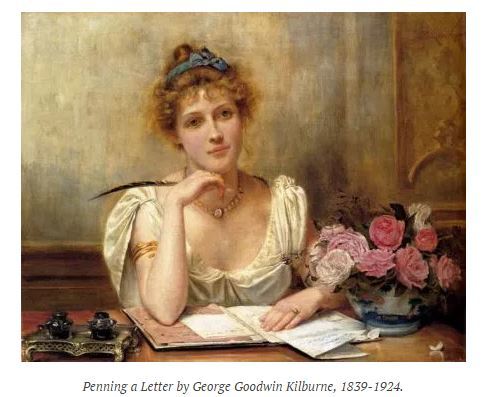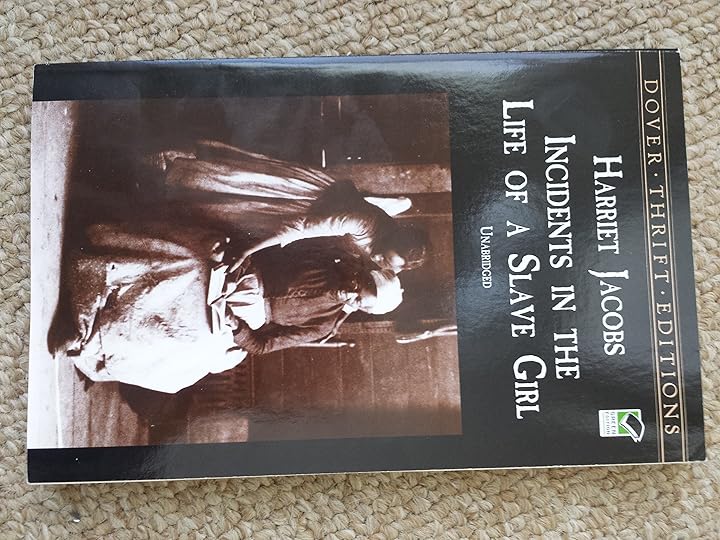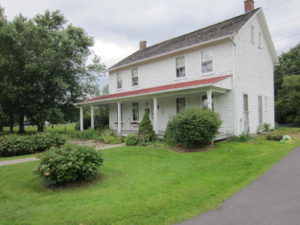Jeanne Gehret's Blog: http://SusanBAnthonyFamily.com/, page 12
February 23, 2017
When Free Speech isn’t Free
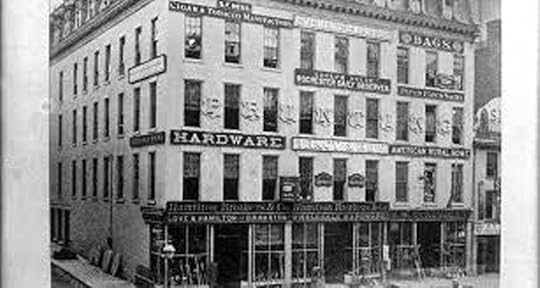 It almost cost Frederick Douglass his home to publish his newspaper in the Talman Building in Rochester, pictured here; and Harriet Jacobs, who operated a reading room with her brother one floor up, couldn’t make her rent, either.
It almost cost Frederick Douglass his home to publish his newspaper in the Talman Building in Rochester, pictured here; and Harriet Jacobs, who operated a reading room with her brother one floor up, couldn’t make her rent, either.
Later, Susan B. Anthony’s publishing ventures racked up six years of crushing debt. People who write and publish, including yours truly, usually do so out of a true passion that defies budgets. If you enjoy this blog, please “like” and “share” it to keep it going, and get your very own copy of The Truth About Daniel to savor.
 As we near the end of Black History Month, consider these stairs where Frederick Douglass’ son said fugitives often awaited his father when the abolitionist came into work at the Talman Building in the morning.
As we near the end of Black History Month, consider these stairs where Frederick Douglass’ son said fugitives often awaited his father when the abolitionist came into work at the Talman Building in the morning.
Please note on the outside of the building the stone letters above the second floor that say “PRINTING.” Rose O’Keefe’s book on Douglass stated that the North Star publisher confessed that the printing equipment he purchased cost too much, making his paper unprofitable. As he began to book more lucrative speaking engagements, he gave the daily management of the paper over to friends, who separated his business finances from those of his family and saved the family’s home. One has to wonder whether the new managers engaged the services of another press in the Talman Building, thus helping to put their newspaper in the black again.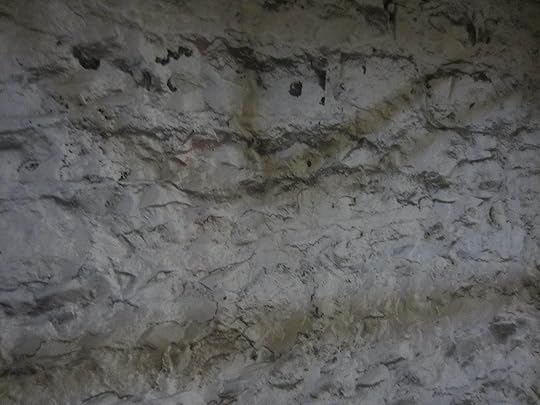 This photo of a wall in the basement near the stairs gives a feel for the age of the building.
This photo of a wall in the basement near the stairs gives a feel for the age of the building.
Exterior photo courtesy of the Democrat & Chronicle, ca 1870 (after A.C. Wilder purchased the building). Interior images by Jeanne Gehret
February 16, 2017
A Time of Confluence
 In 1847 (two years after the Anthonys moved to Rochester) Frederick Douglass settled nearby and began publishing his abolitionist paper The North Star (later called Frederick Douglass’ Paper).
In 1847 (two years after the Anthonys moved to Rochester) Frederick Douglass settled nearby and began publishing his abolitionist paper The North Star (later called Frederick Douglass’ Paper).
Although he had established his writing and speaking career in New Bedford (near Boston), his rising fame threatened or inspired jealousy in some of the luminaries of the movement—most notably William Lloyd Garrison—so he set out in search of a new home.
According to Rochester writer Victoria Sandwick Schmitt, the upstate New York city seemed like a good place for Douglass to settle because:
It was a young and fast-growing city suitable for a new venture for the following reasons:
It was home to an active, enterprising, free African American community.
It was a hotbed of reform movements, including abolitionism.
It was home to a community of Quakers who embraced abolition and racial equality.
Its location near Canada made it a critical site on the Underground Railroad.”
(See Victoria Sandwick Schmitt, “Rochester’s Frederick Douglass” in Rochester History, 8/28/05, p. 12.)
In addition to the favorable socio-economic climate that attracted Douglass to publish his paper in downtown Rochester, the city has a beneficial water feature, as well. Douglass found an office in the Talman Building, located where where an aqueduct carried the Erie Canal over the Genesee River, providing two water routes for fleeing slaves to approach the city. Douglass’ offices for the North Star occupied the Southwest corner of that building, and two floors below him the building’s back door opened onto the water. Douglass’ son recalled that many mornings when his father went into work, he would find fugitives resting on the steps of the building.
Across the street from the Talman Building sat the Reynolds Arcade, one of America’s first indoor shopping malls where you could get everything from a haircut and a cup of coffee to dry goods and the latest news from the telegraph. The Rochester City Directory lists both Daniel Anthony Sr. and his son Daniel Read Anthony as selling insurance on the ground floor of the Arcade. About two blocks away lived Amy and Isaac Post, some of the most active abolitionists in the city of Rochester.
Next time: more on the Talman Building
February 14, 2017
Catch my book on TV today!
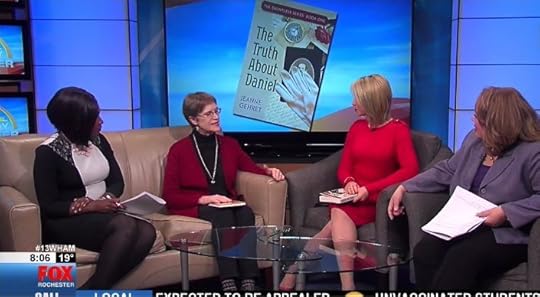 The Truth About Daniel was featured today on FOX morning news. Click here to watch the newscast. I liked how they included images, but you may be confused about the picture of people standing in front of a house. It’s not Daniel’s house in Missouri, but the Anthony farm in Rochester. As far as we know, Daniel lived there with his family of origin before he moved to Kansas with the Emigrant Aid Company.
The Truth About Daniel was featured today on FOX morning news. Click here to watch the newscast. I liked how they included images, but you may be confused about the picture of people standing in front of a house. It’s not Daniel’s house in Missouri, but the Anthony farm in Rochester. As far as we know, Daniel lived there with his family of origin before he moved to Kansas with the Emigrant Aid Company.
Please share this post!
Happy Valentine’s Day to you! I had fun writing the romance portions of this book, especially the three chapters where Daniel bumbles through a proposal to Annie and finally gets it right.
Thanks to the great people at Fox news. They have also filmed our Tool Thrift Shop and our English country dancing group. (Dancing and romancing go hand in hand in The Truth About Daniel.)
February 12, 2017
Penning a (Love) Letter
Valentine’s Day’s coming up, and I will be on Rochester’s WHAMTV13 at 8:50 AM to discuss The Truth About Daniel, which is among other things, a love story.
Let’s consider this romantic painting, which I love for for many reasons. First of all, my husband and I nurtured our long-distance romance with letters for two years. Snail mail made for difficult delays in hearing from my heart-throb, especially since the post office near my Toronto residence often went on strike for a couple weeks. Now, though, I consider myself fortunate to have corresponded with Jon before email because I still have every letter he sent me tied up with a neat bow.
The second reason I love this painting is that the woman looks the way I picture Annie Osborn, heroine of my book, right down to the strawberry blond hair that won’t stay put. And the inkwell reminds me of one I saw in an Anthony collection somewhere. Memory fails me at the moment.
And my third reason is that the letters of Annie and Daniel play a pivotal part in the novel. Like my husband and me, these lovers sometimes experienced lapses in snail mail—and their lapses almost led to romantic disaster.
Just for fun, here’s a picture I took of post office boxes at Alley’s Store on Martha’s Vineyard, near the 19th century home of Annie Osborn.
I highly recommend this post on letters in literature. And don’t forget to watch the news at 8:50 on TV13 WHAM on Valentine’s Day!
Post office box photo by Jeanne Gehret
February 10, 2017
Black History Month: Another Rochester Hero
I’m still processing, both mentally and photographically, what I saw this week at the Talman Building. But here’s one tidbit I brought back for you: my heroine Harriet Jacobs, who self-published this book before the Civil War, had a reading room one floor above Frederick Douglass’s office in the Talman Building. What an amazing, brave woman she was!
If you want to experience for yourself how small a space Harriet hid in for seven years, visit the very worthwhile Underground Railroad exhibit at the Rochester Museum & Science Center. If you can spare the time, plan to spend at least an hour there.
We have much to consider this month! More on Harriet–and Douglass and the Talman Building– later, I promise.
February 8, 2017
The Anthonys in Rochester
I have blogged extensively about the Anthony family in Kansas and Martha’s Vineyard because those two areas were the focus of my first book in “The Dauntless Series.” In the process, I’ve slighted one of the most obvious places anyone should mention when discussing the Anthony family: Rochester, NY, where all of Susan’s nuclear family lived at various times between 1848 and 1907.
So here’s my commitment: I will include the Rochester connection on a regular basis from now on. Not only am I currently researching Rochester sites and people that the Anthonys knew, but I have also created a program entitled “All for Suffrage: the Kin of Susan B. Anthony” where I will share my findings in person with a Powerpoint program. Several libraries have already booked this presentation, in addition to costumed appearances, to celebrate New York State’s centennial of woman suffrage.
If you want to share some Rochester historical tidbits or old photos, please scroll down to the bottom of this page and use the comment box.
I am excited that tomorrow I will be getting a private tour of the Talman Building on Rochester’s Main Street. It was the home of Frederick Douglass’s newspaper The North Star and also a site on the Underground Railroad. Watch for upcoming entries and photos from that visit!
About the photo on today’s post: I never stop puzzling over it. It was taken on the Anthony farm near Rochester, and none of the people in it are identified. Do you find their poses as curious as I do? I like to think that the man on the extreme right is Daniel Read, but have no way of knowing other than that he seems to be copping an attitude!
This is the home where both Daniels–Susan’s father and brother–lived, as well as Merritt. None of the men in the family ever lived on Madison Street, where the famous Susan B. Anthony House stands today. Two chapters of my book take place in this farm home.
February 3, 2017
Black History Month: Harriet Tubman
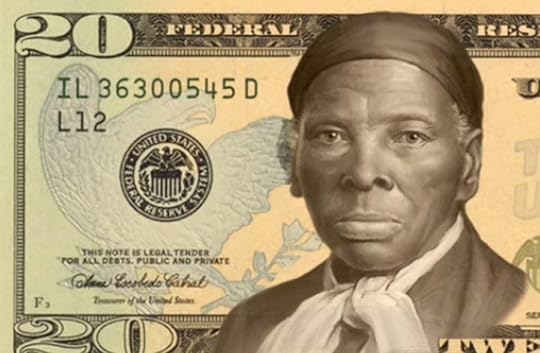
History books used to state that the African-American slaves gained their liberty through the intervention of various whites, from President Lincoln with his Emancipation Proclamation to John Brown with his fiery sword. Now we are beginning to realize that those enslaved people were anything but inanimate “parcels” on a carefully laid-out railroad, but were highly involved in achieving their own freedom. The next few posts will explore this theme because the Underground Railroad plays a prominent role in The Truth About Daniel, just released this month. First, let’s begin with that giant of freedom, Harriet Tubman, whose image will soon be featured on the $20 bill.
Tubman was most active during a ten-year period starting in 1849, when she made her own escape from bondage. By 1856, her face was plastered on a “Wanted” poster offering a $40,000 reward to stop her forays that led hundreds of other blacks to a new life in the North. All told, she made the perilous journey back into slave country at least 19 times by 1860, a year before the Civil War began; before and during the war she freed about 1,000 slaves. Frederick Douglass, who escaped slavery himself, said that except for John Brown, no one had endured more perils and hardships to help others in bondage than Harriet Tubman.
Here’s a photo I took in 2013 at the Harriet Tubman Home for the Aged in Auburn, NY, which has since become a national historic landmark. Here she housed numerous impoverished black people and raised pigs to feed them. She called this charitable enterprise her “last work” and died at the age of 93.
January 30, 2017
Gallop Across the Dance Floor, Anyone?
https://www.youtube.com/watch?v=sgcUhQyAJlo
This is a wonderful video of a 19th century dance. Read more about it below.
I first learned about a dance called the gallopade (or “gallop”) at a concert given by pianist Jacqueline Schwab, whose piano music was featured on Ken Burns’ documentary of the Civil War. Intrigued to see how it was done, I tracked down this video.
The gallopade, a very energetic dance, takes place at a ball in The Truth About Daniel. In this contemporary video, you can hear the laughter that naturally arises from this kind of happy exertion. Notice also that most of the dancers are young! When preparing to dance the gallop, Daniel Anthony, who is 40, searches the room for a young and fit partner.
Notice women dancing with women—this was often done when there were not enough men, which could certainly have been the case on Annie’s island during the Civil War, when many young men were serving on battlefields. In fact, just before a dance recital, Annie asks her best friend to save her a dance so she will not have to partner with a predatory man named Richie.
In this contemporary video, the style of gowns is appropriate to the mid-19th century when Daniel and Annie fell in love. You can see the outline of hoops beneath many of the full skirts, which bob along as the women move energetically across the floor.
Despite the fact that these dancers learned the nine movements of this dance that same day, they make it look effortless, don’t they?
January 27, 2017
Another Paul Revere?
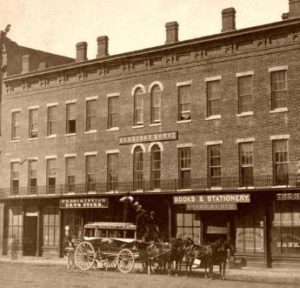 It wasn’t a midnight ride conducted in the midst of political danger. But then, Paul Revere didn’t ride 30 miles alone across Kansas wilderness in an evening snowstorm, either. What would prompt D.R. Anthony to set out on horseback late in the afternoon on January 29, 1861? Nothing less than the joyous announcement that Kansas had been admitted to the Union as a free state.
It wasn’t a midnight ride conducted in the midst of political danger. But then, Paul Revere didn’t ride 30 miles alone across Kansas wilderness in an evening snowstorm, either. What would prompt D.R. Anthony to set out on horseback late in the afternoon on January 29, 1861? Nothing less than the joyous announcement that Kansas had been admitted to the Union as a free state.
The fact of statehood was a significant milestone in the conflict that started with the 1854 Kansas-Nebraska Act, which said that those two frontier territories could choose for themselves whether to enter the Union as slave or free states. The conflict over which way Kansas would go earned it the moniker “bleeding Kansas.”
Just the previous day, D. R. had started a newspaper with his equally radical friend Daniel Webster (“Web”) Wilder. Both were Massachusetts-born and lived for a time in Rochester; both emigrated to Kansas in 1857. On the day the news arrived, Kansas legislators were meeting in Lawrence at the Eldridge Hotel. Leavenworth was the western terminus of the telegraph, which meant that the legislature in Lawrence would be ignorant of the announcement for a day or two.
Here is an account of how D.R. handled the breaking news:
“The news from Washington reached Leavenworth by telegram and an extra edition of that publication with glaring headlines was issued late in the afternoon. With a bundle of ‘extras’ Colonel Anthony rode to Lawrence, where the last territorial legislature was in session. He arrived about 9 o’clock at night and rushed into the Eldridge House shouting the news. It set that Free State town wild with joy.
“‘It was a great stroke of newspaper enterprise,’ an old Kansan said recently. ‘But think of two radicals like Dan Anthony and Web Wilder publishing a paper called the Conservative!’”
Another account mentions that D.R. announced the “momentous tidings” in each town or hamlet he rode through.
Photo of Eldridge Hotel 1867, courtesy of Legends of America
[1] Perl Wilbur Morgan (ed), History of Wyandotte County, Kansas, and Its People, vol 1. Chicago: The Lewis Publishing Company, 1911, p. 157.
January 16, 2017
Big Money from Horses
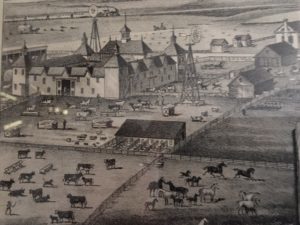 This is a copy of a portion of a large lithograph made by D.R. Anthony in 1888 of his prosperous stock farm in Huron, KS. In the upper left, note the train, which enabled him to get his horses and cattle to market. Subsequent generations of Daniel Read Anthonys continued to enjoy this farm and also recreational property in the vicinity of Martha’s Vineyard, MA where Anna Osborn Anthony was born and raised.
This is a copy of a portion of a large lithograph made by D.R. Anthony in 1888 of his prosperous stock farm in Huron, KS. In the upper left, note the train, which enabled him to get his horses and cattle to market. Subsequent generations of Daniel Read Anthonys continued to enjoy this farm and also recreational property in the vicinity of Martha’s Vineyard, MA where Anna Osborn Anthony was born and raised.
Image courtesy of the Leavenworth County Historical Society.
Today we continue with our guest post about Anthony’s farm, as follows:
—
In 1893, an apple orchard of 5000 trees grew on 80 acres of the ranch and a herd of thoroughbred Holstein cattle provided product for the Anthony’s “Huron Creamery”. Both a school and the Presbyterian Church were constructed on Anthony’s land. In 1883, Col. Anthony donated a new organ for the church as well. DR Anthony Jr. had a cabin here where he could come to relax and hunt quail and pheasant. Ball games and corn plowing contests, fires and a tornado are part of the history of the farm. The tornado of 1891 caused $3000 in damage.
By 1910 there were 300 residents in the town of Huron, which included a bank, schools, several general stores, a blacksmith shop, lumber yard, grocery store, hotel, drug store, hardware and implement house.
The Anthonys hired managers for the ranch over the years with the Starnes family providing the longest service, totaling 75 years over 3 generations. D.R. Anthony III rented out the farm in 1962 and the Anthony family management of 105 years came to an end. In 1963, the main barn, long known as a local landmark, burned to the ground while D.R. III was spending the summer in Edgartown, Massachusetts on Martha’s Vineyard. A 1959 aerial view showed the barn as the centerpiece of the farm.
In 1973, the Anthony property was sold. The Huron post office closed in May, 1992 and the once thriving town seems but a mere dot on the vast Kansas prairie today. The current population of about 50 can be found among long-ago closed or abandoned businesses and schools, many of which harken back to better days. Little is recognizable on the expansive ranch west of town and many do not now know the Anthony name, so prominent many years ago.
Guest post by Mary Ann Sachse Brown of the Leavenworth County Historical Society
http://SusanBAnthonyFamily.com/
or her brother Daniel Read (D.R.) Anthony. I share all of these on my blog. You can also get special insights into my new b Whenever I travel, I stop in to visit a site connected with Susan B. Anthony
or her brother Daniel Read (D.R.) Anthony. I share all of these on my blog. You can also get special insights into my new book The Truth About Daniel, based on D.R.'s romance and his rambunctious days as an original Kansas Jayhawker ...more
- Jeanne Gehret's profile
- 15 followers


